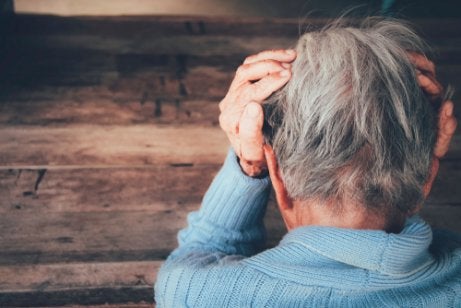Why Is Anxiety Common These Days?


Written and verified by the psychologist Valeria Sabater
Anxiety is common these days, at least according to some studies. It’s currently the most recurrent mental disorder and a great challenge for medical institutions. It’s a business for the pharmaceutical industry and a distressing reality for millions of people around the world. This is because it completely limits their lives. But why is anxiety becoming a sort of epidemic?
Some say the world is now divided into two types of people: those who suffer from anxiety and those who don’t. It’s a mistake to assume this because anxiety is part of being human. In a way, we all know what it’s like, the pain it causes, and how dark reality can be when it prevails.
“Smile, breathe, and go slowly.”
-Thich Nhat Hanh-
Anxiety is becoming more common
Society could be divided into three types of profiles:
- People who are diagnosed with this psychological condition (in any of its forms and variations).
- Those who know how to deal with and manage anxiety.
- Finally, those people who might never be diagnosed because they won’t seek help.
The issue is incredibly complex. However, the good news is that this reality is becoming more and more normalized. For example, the magazine Anxy is quite popular. This is because it tries to make people aware of anxiety and other mental disorders.
Some small steps can help you better understand these situations. Nevertheless, the most important one is the reason for its presence.

Why is anxiety so common?
Is it true that anxiety has become quite common? Is it true the world is facing a real “epidemic”? You may not know it but the definition of “epidemic” has changed quite a bit since the last century.
This word doesn’t only refer to organic diseases, viral conditions, etc. An epidemic is also an event that has a negative impact on the quality of life of many people.
Clinical data indicates that anxiety diagnoses are indeed on the rise since the last decade. Studies such as the one conducted at the University Medical Center of Göttingen in Germany indicate that at least 33.7% of the population in Europe suffers from some kind of anxiety disorder. For instance, they may have a panic disorder with or without agoraphobia, a generalized anxiety disorder, a social anxiety disorder, specific phobias, or a separation anxiety disorder, among others.
Similarly, the prevalence rate is chronic in many cases. Nevertheless, researchers observed in the last years that the older population deals better with this psychological condition. What this means is that the younger population is getting diagnosed.
When stress turns into anxiety
Stress is recurrent throughout the day in many people. Some of them define it as an inherited mechanism that allows them to face and adapt to challenges. In any case, this set of mental and physiological reactions activate in response to work, studies, relationships, and environmental pressure.
But you can advance if you handle it properly. This is because it doesn’t take long for anxiety and anguish to emerge when stress is constant and overwhelming. Ok but, what exactly is anguish? It’s the worst of all emotions, it’s fear. The following internal dynamics appear when this entity appears:
- A person experiences a persistent nameless fear. They no longer know what they’re afraid of because their environment is full of threats they can’t control. Thus, it becomes their worst enemy as a shapeless entity that doesn’t always know why it’s there.
A world marked by uncertainty
Humans live in what sociologists refer to as “the age of uncertainty”. The economic crisis and its effects on your closest reality, the digital revolution, and those constant changes at the political, social, and even personal levels immerse you in a strange sense of helplessness.
Many books discuss this. People are immersed in a scenario in which it’s difficult to find professional stability. Nowadays, young people go to college but have few job prospects.
Anxiety is common these days because the human brain needs certainty and security. However, the current environment offers just the opposite.

I feel lonely but nobody sees me
Loneliness is another epidemic with similar characteristics. Older people are isolated and this is a challenge society must address. However, young people are also carrying the weight of loneliness.
The data indicates that millennials are displaying more and more anxiety. Thus, one can’t ignore the fact that suicide rates among teenagers are on the rise.
Factors such as bullying, harmful social relationships, low self-esteem, poor emotional management, and the pressure of social networks (where reality is so distorted) all take a huge toll at a psychological level.
As you can see, this is another cause of why more people are experiencing anxiety these days.
What to do about anxiety
What’s the solution, then? Well, there’s no single solution but many. The first one is to be aware that you can’t control your surroundings. Society is changing. It puts pressure on you and demands things from you.
There’s only one option in the face of something you can’t control: develop adequate coping and emotional management skills. Nowadays, therapies such as cognitive-behavioral can be of great help in this regard. However, society needs more strategies.
Drugs aren’t the solution either. Although they help, they neither treat nor solve the problem. As you can see, the world needs more resources, social support, and adequate prevention systems. There should be resources and specialized personnel in schools, institutes, universities, workplaces, and health centers so that psychological support is accessible to everyone.
Similarly, you must educate yourself about emotional matters. Learn to manage your fears and irrational thoughts and learn to respond better to your daily difficulties.
In any case, all of this remains an immense challenge today. For this reason, remember that you shouldn’t hesitate to ask for help. Don’t let fear and anguish push you to the limit.
All cited sources were thoroughly reviewed by our team to ensure their quality, reliability, currency, and validity. The bibliography of this article was considered reliable and of academic or scientific accuracy.
- Baxter AJ, Scott KM, Vos T y Whiteford HA (2012) Prevalencia global de trastornos de ansiedad: una revisión sistemática y una metarregresión. Medicina Psicológica, 43, 897-910.
- Baxter AJ, Scott KM, Ferrari AJ, Norman RE et al. (2014) Desafiando el mito de una “epidemia” de trastornos de salud mental comunes: tendencias en la prevalencia global de ansiedad y depresión entre 1990 y 2010. Depression & Anxiety, 31, 506-516.
- Martin P & Martin-Grane E (2006) Evolución de 2,500 años del término epidemia. Enfermedades infecciosas emergentes, 12, 976-980.
- Kaczkurkin AN & Foa EB (2015) Terapia cognitivo -conductual para los trastornos de ansiedad: una actualización sobre la evidencia empírica. Diálogos en la neurociencia clínica, 17, 337-346.
This text is provided for informational purposes only and does not replace consultation with a professional. If in doubt, consult your specialist.








